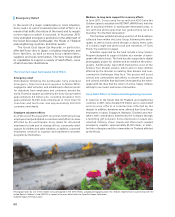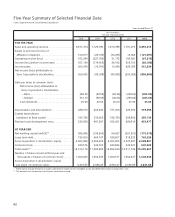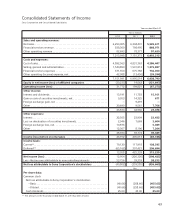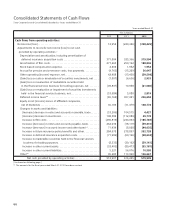Sony 2012 Annual Report Download - page 58
Download and view the complete annual report
Please find page 58 of the 2012 Sony annual report below. You can navigate through the pages in the report by either clicking on the pages listed below, or by using the keyword search tool below to find specific information within the annual report.
Environmental Activities within Sony’s Operations
Curbing Climate Change—Reducing greenhouse gas emissions at sites
In fiscal year 2011, greenhouse gas emissions at Sony Group sites were approximately 1.50 million
tons, down approximately 32% from fiscal year 2000. To reduce greenhouse gas emissions, Sony has
positioned improvements in the efficient use of energy at its sites as its greatest environmental
priority. This eort encompasses initiatives in both infrastructure and systems, including the intro-
duction of energy-ecient facilities and deployment of an internal training program for the Company’s
energy conservation experts. For example, Sony Pictures Entertainment released the film Think Like
a Man in 2011, which was the industry’s first-ever production filmed entirely with LED lighting.
Sony is also aggressively pursuing the use of renewable energy. In fiscal year 2011, Sony succeeded
in offsetting global greenhouse gas emissions by 123,000 tons through the use of renewable
electricity certificates and other initiatives. Electricity acquired from renewable sources accounted
for approximately 10% of Sony’s total electricity purchases worldwide. Further, with regard to perfluoro-
carbons (PFCs) and other greenhouse gases emitted in the production of semiconductors and LCD
panels, Sony is working to reduce emissions through the introduction of treatment equipment that
traps such gases.
Conserving Resources—Reducing waste at sites
In fiscal year 2011, total waste generated by Sony Group sites amounted to approximately 116,000
tons, a reduction of approximately 58% from fiscal year 2000. Sony Group’s total recycling rate was
90%. Sony continues to promote the reuse and recycling of site waste in its products and packaging
materials on a global basis.
Conserving Resources—Reducing water consumption at sites
In fiscal year 2011, Sony Group sites used approximately 16.7 million m3 of water during its operations,
comprising water purchased or drawn from groundwater. This was a reduction of approximately 38%
compared with fiscal year 2000. Sony is taking steps to reduce water used by its sites around the
world.
Managing Use of Chemical Substances—Management of chemical substances at sites
Sony has developed Groupwide standards with respect to the management of chemical substances
used at sites and has implemented measures aimed at reducing the amounts of such substances
transferred and released into the air and water as emissions or waste. In fiscal year 2011, emissions of
volatile organic compounds (VOCs) released into the atmosphere amounted to approximately 1,193
tons, a 35% reduction from the fiscal year 2000 level. Sony has also established internal standards for
the prevention of environmental accidents, as well as for emergency responses, as part of its eorts
to ensure the proper management of chemical substances.
Conserving Biodiversity—Measures to conserve biodiversity
Under policies and guidelines related to biodiversity, Sony is promoting ongoing activities to incor-
porate more green spaces at its various facilities and to preserve and restore the natural environ-
ment. For example, since 1998, the Kohda Site of Sony EMCS Corporation in Japan has maintained the
Sony Forest, located on the factory’s grounds, and has made it available to the local community. In
recognition of these eorts, the Kohda Site received Superlative Stage certification in 2011, the high-
est level of certification available under the Social and Environmental Green Evaluation System
(SEGES)*, making it the first such site in Japan to receive this distinction.
* SEGES is an evaluation and certification program run by the Urban Green Space Development Foundation.
SEGES evaluates businesses’ green spaces and the contribution to society and the natural environment these
businesses are making through the protection and nurturing of such spaces. SEGES particularly recognizes
outstanding initiatives by businesses.
(F)
Greenhouse gas emissions from energy consumption
Emissions of PFCs and other greenhouse gases
calculated in terms of CO2
2.22
2000 2010
1.53
2011
1.50 1.55
2015
Target
2015
Target (F)
2
12 11 13
2000 2010 2011
2015
Target (F)
2
1 1 1
2000 2010 2011
2015
Target (F)
1,3
1,1 1,13
1
2000 2010 2011
Greenhouse Gas Emissions
from Sites
(Millions of tons of CO2)
Waste at Sites
(Thousands of tons)
Release of VOCs into the
Atmosphere
(Tons)
Water Consumption at Sites
(Millions of m3)
56
























